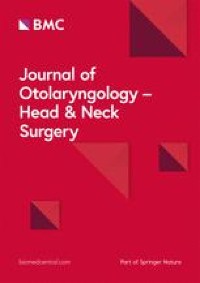|
Medicine RSS-Feeds by Alexandros G. Sfakianakis,Anapafseos 5 Agios Nikolaos 72100 Crete Greece,00302841026182,00306932607174,alsfakia@gmail.com
Πληροφορίες
Κυριακή 27 Ιουνίου 2021
Images: Unilateral rhinorrhea in a patient starting autotitrating positive airway pressure therapy for obstructive sleep apnea
Proceedings of the Canadian Thyroid Cancer Active Surveillance Study Group 2019 national investigator meeting
|
Fixed vs Measured Length of Stapes Prosthesis in Stapes Surgery
|
Survival and toxicity in patients with human papilloma virus‐associated oropharyngeal squamous cell cancer receiving trimodality therapy including transoral robotic surgery
|
Surgical Outcome of Potassium-Titanyl-Phosphate (KTP) Laser Photocoagulation for Vocal Fold Vascular Lesions
|
The Acid Test: Proton Pump Inhibitors in Persistent Throat Symptoms: A Systematic Review of Systematic Reviews
|
Characterization of otologic involvement in patients with X‐Linked Hypophosphatemia
|
The diagnostic utility of clinical exome sequencing in 60 patients with hearing loss disorders: A single‐institution experience
|
The Role of the Skin Microbiota in the Modulation of Cutaneous Inflammation‐ Lessons from the Gut
|
Can plantar fibroblast implantation protect amputees from skin injury? A recipe for skin augmentation
|
Severe acute orthostatic headache: spontaneous intracranial hypotension (SIH)
|
Perceptual awareness negativity: a physiological correlate of sensory consciousness
|
Αρχειοθήκη ιστολογίου
-
►
2023
(366)
- ► Φεβρουαρίου (184)
- ► Ιανουαρίου (182)
-
►
2022
(2814)
- ► Δεκεμβρίου (182)
- ► Σεπτεμβρίου (213)
- ► Φεβρουαρίου (264)
- ► Ιανουαρίου (262)
-
▼
2021
(3815)
- ► Δεκεμβρίου (229)
- ► Σεπτεμβρίου (276)
-
▼
Ιουνίου
(441)
-
▼
Ιουν 27
(25)
- Images: Unilateral rhinorrhea in a patient startin...
- Proceedings of the Canadian Thyroid Cancer Active ...
- Fixed vs Measured Length of Stapes Prosthesis in S...
- Survival and toxicity in patients with human papil...
- Surgical Outcome of Potassium-Titanyl-Phosphate (K...
- The Acid Test: Proton Pump Inhibitors in Persisten...
- Characterization of otologic involvement in patien...
- The diagnostic utility of clinical exome sequencin...
- The Role of the Skin Microbiota in the Modulation ...
- Can plantar fibroblast implantation protect ampute...
- Severe acute orthostatic headache: spontaneous int...
- Perceptual awareness negativity: a physiological c...
- Comparative Analysis of Cortical Auditory Evoked P...
- Multicentric Intra/Extracranial Cystic Facial Nerv...
- FACE-Q craniofacial module: Part 2 Psychometric pr...
- Lymphography change after liposuction: Possible ne...
- New European Medicines Agency approval: Tucatinib ...
- SEC61G identified as a prognostic biomarker of hea...
- Audiological results and subjective benefit of an ...
- The Effects of Neurodevelopmental Therapy on Feedi...
- Supracricoid Partial Laryngectomy With and Without...
- The impact of COVID‐19 on elective otolaryngology ...
- The role of sepsis screening, SIRS and qSOFA in He...
- Increased incidence of unilateral sudden sensorine...
- Prognosis and Outcomes in Early Stage Glottic Carc...
-
▼
Ιουν 27
(25)
- ► Φεβρουαρίου (64)
-
►
2020
(5754)
- ► Δεκεμβρίου (401)
- ► Σεπτεμβρίου (365)
- ► Φεβρουαρίου (754)
- ► Ιανουαρίου (894)
-
►
2019
(146)
- ► Δεκεμβρίου (19)
- ► Σεπτεμβρίου (54)





